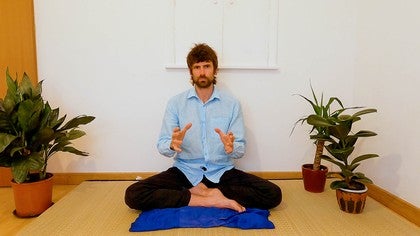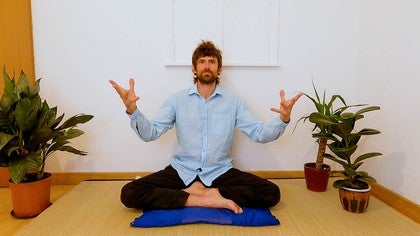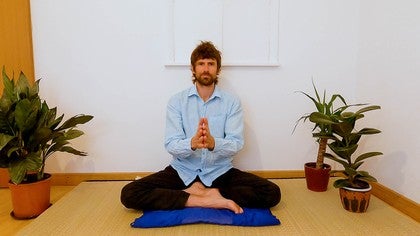Description
About This Video
Transcript
Read Full Transcript
So Patanjali has told us in the Fifteenth Sutra that wise ones see that all types of worldly experience, even if they are very agreeable and very pleasant, they carry the germ of future suffering. And then he's told us, however, the pain that is not yet come is to be avoided. And the next sutra, Patanjali starts to get into some of the, he's already told us that avidya, this not seen clearly, is the field in which all these afflictions operate. But now we're going to get a little bit more detailed on how it is that this field of avidya enmeshes us in this suffering and this ignorance. Before we get into Sutra Seventy, there's just one more thing I'd like to say about this idea that everything is painful to the wise and how yoga is very practical. It doesn't want us to wallow in that or get stuck in that. So if we, and yoga recognizes that everything we do is training, everything is practice. So if we recognize that, oh, even if we're enjoying ourselves, there is the, it carries the germ of pain. If we start to dwell on that, what happens? We just get stuck in a rot. The idea is, let us enjoy, but as far as possible, not get attached to what we are enjoying. And so this is what starts to be elaborated, how to do this in the next section of the text. So Sutra Seventy, we get some important new terminology introduced. So Sutra Seventeen says, so the word hetuhu, the cause, and heya, removal. So we had the idea in the previous Sutra, the pain that has not yet come, we want that to be removed. Let's avoid it if we can. Why not? That sounds like a good policy. So he potentially says, what is the cause of this pain that has not yet come? So notice here the pragmatism of the yoga system. Here we are, and up until now, we have experienced pain and suffering. It's gone. It's done. It's already experienced. So don't worry about that. Let's focus on the pain that is not yet come, and let us work on mitigating that. Let us work on meeting that skillfully. And so it potentially says, drastre drishya yoho. This means the drastre and drishya. These are these two terms we need to introduce. Drastre means the seer, the one that sees, the conscious principle, and drishya, the seen, the manifest existence that the seer experiences. So for example, right now, here I am, and if I look at the plant, I look at the mat, I look at the wall, I look at the camera, for illustration's sake, I am the seer, and these things are the seen. What is though enabling me to be the seer is my consciousness, the underlying conscious awareness. And then all these manifest objects, they are the seen. So drastre drishya yoho, sai yoga ha, hei yahito. So here we have the word, sai yoga ha. Oh, yoga with the prefix sum. So let's talk about three terms that are related. San yoga, vi yoga, and yoga. We are interested, we're studying yoga sutra, we would like to experience yoga. And yoga is always in the middle. Yoga is the state of being centered. And yoga also means that the past participle of the verb that gives us yoga is yukta. And yukta means connected, joined. San yoga means very well joined. Vi yoga means very feebly joined or not joined at all. So I'd invite you to do a little exercise with me. Bring your hands together and interlace your fingers like this. And now pull your hands apart. And feel it's like you're two elbows to fly into the two walls to either side of you. But keep your shoulders down your back. And so you really start to feel a strong muscular engagement in your upper back, perhaps in your chest, in your arms and your shoulders. And really, really pull. Keep going, really, really pull. Is this comfortable? Is this sustainable? If you're already pulling hard, you start to feel some excess tension.
This is san yoga. It's very well connected. If I do that for too long, what do I want to do? I want to let go. And then vi yoga. Not very well connected, not connected, not joined up. So san yoga, it's connected, but excessively so. It's this very strong attachment. It's a very strong connection. Vi yoga, there isn't much of a connection at all. It's not a strong connection or it's not connected. San yoga, vi yoga. What do we want? Yoga. So if you join your hands like this now, again, relaxing the shoulder blades down the back. I need to shake out the tension from doing the san yoga exercise. But now I join my hands at the finger base and the fingertips, relax the shoulders, relax the forehead. This is a yogic gesture. It's connected, but it's sustainable. I can enjoy this connection. For one thing, it's helping connect the two hemispheres of my brain because the nerve endings in the right fingertips, they correspond to the left hemisphere of the brain and vice versa. So as I do this, it's a yogic gesture. It's connected, it's joined up, but it's sustainable. So we're interested in yoga, that balance state, but all too often what happens when we're san yoga, when we're gripping something, there's this excess tension. It kind of narrows and confines our perspective. So we can't see clearly. So it's avidya and partiality and fragmentation. And if we're vi yoga, it's like we're not already present.
We're not joined up. And if we're not joined up, we're not going to be able to experience that deeper, subtler underlying conscious essence. So we want to cultivate yoga, that sweet spot in the middle. Now what happens in life? Speaking for myself anyway, what can I say is that sometimes in life, I'm kind of in a san yoga type of situation. I am rolling along and I am clinging to things being a certain way. I am attached to things moving in a certain pattern or according to my expectations, according to my pre-established programs, and I am well connected to them. And because of that, it kind of stops me seeing the bigger pictures like I get a kind of blinkered or tunnel vision. And other times in life, I'm going to just vi yoga. I'm not so present and I don't realize how I'm just kind of floating along on my own autopilot patterns without being so present. So we want to cultivate yoga. So san yoga is when there is this very strong connection in terms of our understanding of who we are between the seer and the scene. So in other words, we basically misunderstand who we are. We confuse ourselves with the instruments, the bodily vehicle, the lenses of our habits and ideas and sense of identity. We get associated with all of those things that are really part of the drishya. They're part of the scene because they're things that are subject to change. They are not the underlying constant conscious essence, but we get identified with the changing stuff of nature. And so this san yoga is getting attached to limited false understanding of who we are. This is the cause of the pain that is to be removed. So can we move from this san yoga state of being attached and consequently being partial, being deluded, being enmeshed, imprisoned in a particular and limiting and limited sense of reality and who we really are? And can we come to yoga a clear balanced integrated state? So what does this mean? Practically, can we break this overly strong conjunction? Can we extricate ourselves from our identifications, our self-identity that is limiting, that is bound up with these things that are actually coming and going and are not really our underlying essential nature? So a really good question to inquire into and work with this is, where am I acting from? Am I acting from my attachments? Am I trapped within my pre-existing ideas? Are my thoughts really my own? Or have they been shaped and manipulated and kind of impressed upon me by things I've come into contact with in the external realm? Or am I acting from my own conscience, from my own deeper wisdom, my own deeper presence? Or am I just kind of carelessly rolling along on autopilot programmes that may not really be serving me and are certainly not helping me recognise my ultimate nature? So where am I acting from? Ultimately, the state that the yoga sutra invites us to, as well as samadhi, is sometimes referred to as kaivalya. And this is a word we'll encounter fairly soon in this chapter. In kaivalya sometimes it's rendered or translated as freedom. Sometimes it's translated or rendered as independence and sometimes as aloneness in the sense of all oneness. Now this sense of all oneness we experience when we become a true individual, in the sense of a person that is no longer subject to division. We are an indivisible entity because we are no longer identified with divisive ideas that come and go. We have allowed ourselves to recognise the underlying conscious essence that is actually made of the unchanging stuff of pure consciousness. Now, in order to access that, part of the game is to extricate ourselves from our conditioned ideas. So am I an independent thinker? Perhaps nowhere near to the degree that I might think I am. And so this practice that is inherent to yoga, we've said at the beginning of this chapter, tapaha svaadhyaya ishwarapranidhana. Svaadhyaya, this constant inquiry, this constant pursuit of what is really going on here. In the words of Eric Schiffman, who also has content here on yoga or any time, what's the truth here really? That's one of the questions that he really recommends to enquire with. And I would just mention, if you are not aware of it, there is a teacher called, I don't know if he's really a teacher but I consider him so, a man called Daniel Schmacktenberger and some of what he has shared speaking about the need for deep inquiry if we are to make sense of the world is very, very useful. So I'd also recommend his work in relation to this sutra and relation to this practice that yoga is urging us to, to really explore the epistemological underpinnings of how we relate to reality. So epistemology is how we decide if something is real or not. So yoga makes it really clear. It's very easy for our sense of reality to be tinged, tinted by all these different conditioned ideas. If we are to remove these partialities, we have to examine our thinking very rigorously, very thoroughly. And this is one of the reasons why everything for the wise is tinged with suffering because what happens when we recognise that we have been deluding ourselves and we've been complicit in our own delusion and we've been getting in our own way, it rankles, it burns. It is not pleasant. We have to learn to digest this in the fire of our tapas. So the idea is as we practise diligently, regularly, committedly, the fire of practise illuminates. It helps us see things we were previously blind or oblivious or blinkered to or even willfully ignorant of. However, the light of our centred awareness can gradually start to transmute those things as we bring them into our centred awareness, we can start to work with them skilfully. And as we start to gain a fuller grip on how we are interacting and interfacing with reality, we can start to move from sun yoga towards yoga.
Yoga Sutras of Patanjali: Life is the Guru
Comments

You need to be a subscriber to post a comment.
Please Log In or Create an Account to start your free trial.








